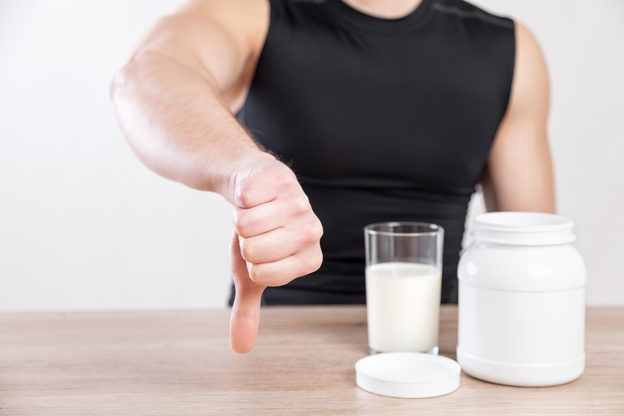By David Blyweiss, M.D., Advanced Natural Wellness
October 14, 2020
Have you walked down the health food aisle lately?
The last time I did, I saw all sorts of products… protein drinks, protein bars, big tubs of protein powder.
People just seem obsessed with getting enough protein. Why the interest? Well, they’re interested in building or keeping their strong muscles.
When my own patients have asked me about the right amount of protein to eat, my answer sometimes surprises them.
That’s because you actually need a lot less protein as you get older. You’re not building muscle mass like you were back in your days of youth.
One study looked at the amount of lean muscle mass in 52 people who were doing a 12-week resistance exercise training. They found that the amount of protein eaten in the form of a protein shake did not result in more lean mass gains for people ages 60-69 years.[1]
That’s because your body is being affected by something called sarcopenia. It’s a term used to describe the loss of muscle mass, strength and function due to age.[2]
I’m sure you’ve noticed some huge changes in your body as the years go by. Your muscle mass actually began to decrease by 3-8% per decade after you turned 30. This rate speeds up even more after the age of 60.[3]
MD Exposes the Hidden Danger to Your Eyes

When your eyesight starts to fail, it's a real problem. Suddenly you can't go to the grocery store... you can't get to the doctor if you have an emergency... you can't meet your friends for dinner…
Your "regular" doctor doesn't have time to keep up with the latest research. And the same goes for eye doctors. They go to school to learn how to fit you for glasses and contacts, but have no way of preventing the damage and loss of eyesight that threatens your freedom and independence.
Let me show you something that explains a LOT about how your eyes work.
In my FREE Special Report, I'll show you a HUGE, untapped resource for your eyes that safely and naturally restores clear, effortless eyesight.
Click here to get started...
This is a major reason why elderly people become disabled. This loss of muscle mass increases your risk of falls and makes you more vulnerable to injury.[4]
Not only is your muscle mass going down, but your fat mass goes up for an overall change in body composition. This can cause an increased level of insulin resistance in the elderly.[5]
Then, bone density decreases, you start to shrink in height and joints become stiffer.
Getting old sure is fun, right?
I’m very proud to say that I’ve only lost about a quarter of an inch in my own height since I was 18. That’s 50 years. But I also know what to do to keep myself strong and tall.
I have a zero gravity chair that I sit in every night to open up the spaces between my vertebrae. Plus, I go for a brisk walk every single day to keep myself strong.
But, I digress. Let’s get back to the protein talk.
How Much Protein Do You Really Need?
As a general rule of thumb the recommended dietary allowance (RDA) for protein is 0.8 grams per kilogram of body weight. That comes out to about 0.36 grams per pound.[6]
So, for an average person, that’s about 70 grams of protein per day.
Eating much more than that really isn’t necessary. In fact, in some situations it could be bad for you. One study found that women with existing kidney problems made their condition worse with a high protein diet. [7]
Are You Suffering From...
- Love handles and a pot belly
- Romance that isn't what it used to
- Forgetfulness and inattention
- Low (or no) strength and endurance
- A sex drive that's shifted into neutral...or worse
If so...you may have Mature Male Burnout. Click here to discover more about this unique condition and what you can do about it.
Meat is important for high-quality protein and vitamin B, but eating the wrong kinds of protein is also a bad idea. For instance, one study found that a diet high in processed meats is associated with higher risks in seniors.
They studied 2,983 people and found that too much processed meat resulted in lowered levels of agility and lower-body movement. Replacing processed meat with other protein sources may slow the decline of physical function in older adults.[8]
Your choices between vegetable proteins versus animal proteins also makes a difference. Senior women who eat a lot of animal protein rather than vegetable protein are at greater risk for hip fractures.[9]
My Favorite Tasty Protein Ideas
Personally, I eat protein every day, but I don’t eat that much. In fact, I haven’t had a big juicy steak in probably four months.
The last time I did it was a two-inch grass-fed, rib-eye steak. It was probably a pound and a half in size, so I carved off four or five slices and put it over vegetables…and it was dinner the next night over risotto and asparagus. Usually, I marinate meats like this as a treat rather than a staple of my diet, keeping 85% of my plate plant based.
Remember, everything you feed your body is also feeding your gut microbiome. That can be an issue with protein from animal products. Our gut bacteria do not like animal products, so it results in the wrong populations for ideal health.
Instead, I recommend focusing on plant-based foods most days of the week. People over the age of 65 years should focus on high quality, nutrient-dense foods.[10] Stay away from too much dairy and use meat as only 13% or so of your total intake.
Like today… I had an egg salad sandwich and some vegetables. It was delicious! I also love lamb that has been braised. I love wild caught fish rich in omega-3 fatty acids or buffalo meat as an alternative to beef.
If you’re looking for a vegetarian option, try a vegan hamburger with a gluten-free roll and a little ketchup, mustard, grilled onions, lettuce and tomato. Broccoli, Brussel sprouts, lentils, or quinoa are also higher protein options.
I think Michael Pollan, author of the book In Defense of Food said it best. He said, “Eat food, not too much, mostly plants.”
Sources:
[1] Andrews, R. D., MacLean, D. A., & Riechman, S. E. (2006). Protein Intake for Skeletal Muscle Hypertrophy with Resistance Training in Seniors, International Journal of Sport Nutrition and Exercise Metabolism, 16(4), 362-372. Retrieved Sep 17, 2020, from https://journals.humankinetics.com/view/journals/ijsnem/16/4/article-p362.xml
[2] Evans WJ, J Gerontol A Biol Sci Med Sci. 1995 Nov; 50 Spec No():5-8.
[3] The biology of aging.Holloszy JO, Mayo Clin Proc. 2000 Jan; 75 Suppl():S3-8; discussion S8-9.
[4] Wolfson L, Judge J, Whipple R, King M. Strength is a major factor in balance, gait, and the occurrence of falls. J Gerontol A Biol Sci Med Sci. 1995;50:64–67.
[5] Melton LJ, III, Khosla S, Crowson CS, et al. Epidemiology of sarcopenia. J Am Geriatr Soc. 2000;48:625–630.
[6] Food and Nutrition Board, Institute of Medicine. Dietary Reference Intakes for Energy, Carbohydrate, Fiber, Fat, Fatty Acids, Cholesterol, Protein, and Amino Acids. Washington, DC: National Academy Press, 2002.
[7] Knight EL, Stampfer MJ, Hankinson SE, Spiegelman D, Curhan GC. The impact of protein intake on renal function decline in women with normal renal function or mild renal insufficiency. Ann Intern Med. 2003;138(6):460-467.
[8] Struijk, E.A., Banegas, J.R., Rodríguez-Artalejo, F. et al. Consumption of meat in relation to physical functioning in the Seniors-ENRICA cohort. BMC Med 16, 50 (2018). https://doi.org/10.1186/s12916-018-1036-4
[9] Sellmeyer DE, Stone KL, Sebastian A, et al. A high ratio of dietary animal to vegetable protein increases the rate of bone loss and the risk of fracture in postmenopausal women. Am J Clin Nutr 2001;73:118-22.
[10] J Blumberg (1997) Nutritional needs of seniors., Journal of the American College of Nutrition, 16:6, 517-523, DOI: 10.1080/07315724.1997.10718714







